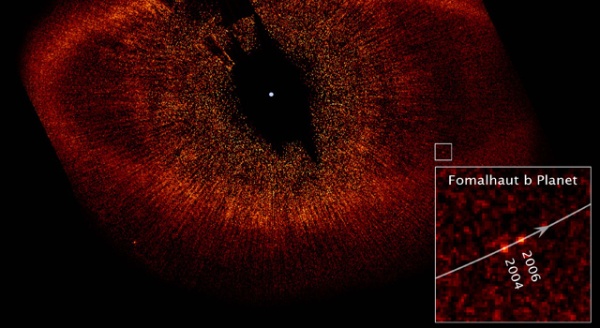
Posted on Tuesday, November 18 2008 @ 3:00 CET by Thomas De Maesschalck
The Hubble Telescope has taken the first ever pictures of a planet circling another star 25 light-years away, the newly discovered planet is called Fomalhaut b and it's estimated to be no more than three times Jupiter's mass. The planet orbits the bright southern star Fomalhout, which is located in the constellation Piscis Australis.
Fomalhaut has been a candidate for planet hunting ever since an excess of dust was discovered around the star in the early 1980s by NASA's Infrared Astronomy Satellite.
In 2004, the coronagraph in the High Resolution Camera on Hubble's Advanced Camera for Surveys produced the first-ever resolved visible-light image of the region around Fomalhaut. It clearly showed a ring of protoplanetary debris approximately 21.5 billion miles (34.6 billion kilometers) across and having a sharp inner edge.
This large debris disk is similar to the Kuiper Belt, which encircles our solar system and contains a range of icy bodies from dust grains to objects the size of dwarf planets, such as Pluto.
Hubble astronomer Paul Kalas, of the University of California at Berkeley, and team members proposed in 2005 that the ring was being gravitationally modified by a planet lying between the star and the ring's inner edge.
Circumstantial evidence came from Hubble's confirmation that the ring is offset from the center of the star. The sharp inner edge of the ring is also consistent with the presence of a planet that gravitationally "shepherds" ring particles. Independent researchers have subsequently reached similar conclusions.
Now, Hubble has actually photographed a point source of light lying 1.8 billion miles (2.9 billion kilometers) inside the ring's inner edge. The results are being reported in the November 14 issue of Science magazine.
"Our Hubble observations were incredibly demanding. Fomalhaut b is 1 billion times fainter than the star. We began this program in 2001, and our persistence finally paid off," Kalas said.
"Fomalhaut is the gift that keeps on giving. Following the unexpected discovery of its dust ring, we have now found an exoplanet at a location suggested by analysis of the dust ring's shape. The lesson for exoplanet hunters is 'follow the dust,'" said team member Mark Clampin of NASA's Goddard Space Flight Center in Greenbelt, Md.
Read more
at NASA.

